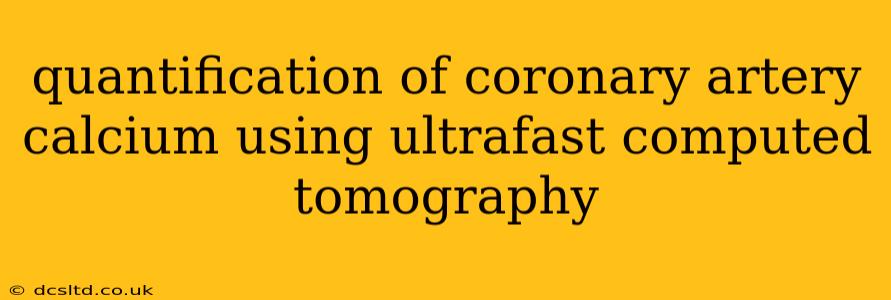Coronary artery calcium (CAC) scoring using ultrafast computed tomography (CT) is a powerful non-invasive technique for assessing cardiovascular risk. This method provides a quantitative measure of calcium deposits in the coronary arteries, offering valuable insights into the presence and extent of atherosclerosis, a major contributor to heart disease. Understanding how CAC quantification is performed and interpreted is crucial for both clinicians and patients.
What is Coronary Artery Calcium (CAC) Scoring?
CAC scoring quantifies the amount of calcium buildup in the coronary arteries. Calcium deposits are a hallmark of atherosclerosis, a process where plaque builds up inside the artery walls, narrowing the arteries and restricting blood flow to the heart. High CAC scores indicate a greater burden of atherosclerosis and a higher risk of future cardiovascular events like heart attack or stroke. The absence of detectable calcium, on the other hand, suggests a lower risk.
How is CAC Scoring Performed Using Ultrafast CT?
Ultrafast CT scanners, with their ability to acquire images rapidly, are ideally suited for CAC scoring. The procedure is quick, painless, and involves minimal radiation exposure. During the scan, a patient lies on a table that slides through the CT scanner. The scanner rotates around the patient, capturing multiple cross-sectional images of the heart and coronary arteries. Specialized software then analyzes these images to detect and quantify the amount of calcium present in the coronary arteries. The quantification is typically expressed as an Agatston score, a widely used and standardized measure.
What is the Agatston Score?
The Agatston score is the most common method for reporting CAC. It takes into account both the amount and density of calcium in each coronary artery segment. Higher Agatston scores reflect a greater amount of calcium and increased cardiovascular risk. A score of zero indicates the absence of detectable calcium. The score's interpretation is typically done in conjunction with other risk factors, such as age, cholesterol levels, blood pressure, and smoking status.
What are the Advantages of Using Ultrafast CT for CAC Scoring?
Ultrafast CT offers several advantages over other methods for assessing cardiovascular risk:
- High Accuracy and Precision: Ultrafast CT provides accurate and precise measurement of coronary artery calcium.
- Non-invasive Procedure: The procedure is non-invasive, avoiding the need for cardiac catheterization, a more invasive procedure.
- Fast Scan Time: The scan time is short, making it convenient for patients.
- Wide Availability: Ultrafast CT scanners are widely available in many medical centers.
- Excellent Spatial Resolution: The high resolution allows for the precise identification and quantification of calcium deposits.
How is CAC Scoring Interpreted?
The interpretation of a CAC score depends on several factors, including the patient's age, gender, other risk factors, and clinical presentation. A CAC score is not a diagnostic test in itself; rather, it's a risk stratification tool. Clinicians use the CAC score alongside other risk factors to determine the overall cardiovascular risk and guide treatment decisions. The higher the score, generally, the higher the risk. However, even a low CAC score doesn't eliminate the possibility of future cardiovascular events, and a zero score doesn't guarantee a lifetime free from heart problems.
What are the Limitations of CAC Scoring?
While CAC scoring is a valuable tool, it does have some limitations:
- It doesn't directly measure plaque composition: CAC scoring only measures calcium, not the other components of atherosclerotic plaque that may contribute to cardiovascular events.
- Not all calcium is clinically significant: Some calcium deposits may be clinically insignificant, while others may represent significant stenosis (narrowing) of the arteries.
- Radiation Exposure: Although minimal, there is still some radiation exposure associated with the procedure.
What is the Role of CAC Scoring in Risk Assessment?
CAC scoring plays a significant role in risk assessment by providing a more precise measure of atherosclerosis than traditional risk factors alone. It helps identify individuals at intermediate risk who may benefit from more aggressive risk factor modification or even medical therapies to prevent future cardiovascular events. The information can be used to make personalized recommendations and tailor preventive strategies.
Does CAC Scoring Predict Future Cardiovascular Events?
Studies have shown a strong correlation between CAC scores and the risk of future cardiovascular events. Higher CAC scores are associated with an increased risk of heart attack, stroke, and cardiovascular death. However, it’s crucial to remember that the score is only one piece of the puzzle and should be considered alongside other clinical risk factors.
Who Should Undergo CAC Scoring?
CAC scoring is typically recommended for individuals at intermediate risk for cardiovascular disease. This might include individuals with several risk factors but without overt clinical evidence of heart disease. The decision to perform CAC scoring should be made in consultation with a healthcare professional, considering the individual's risk profile and the potential benefits and limitations of the test. It's not a routine screening test for everyone.
This information is for educational purposes only and should not be considered medical advice. Consult with a healthcare professional for any concerns about your cardiovascular health.
